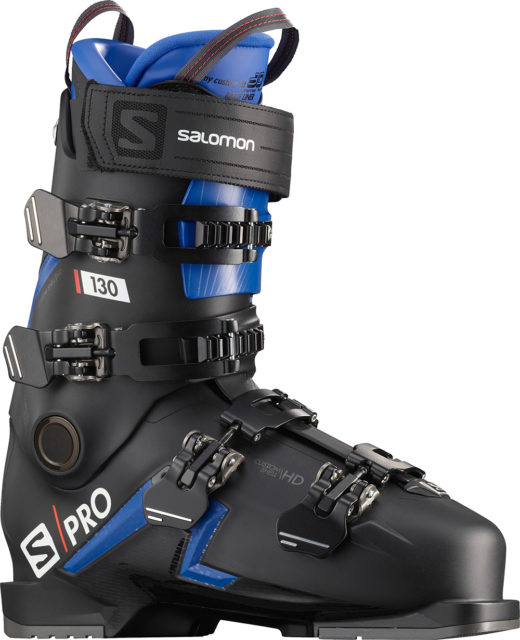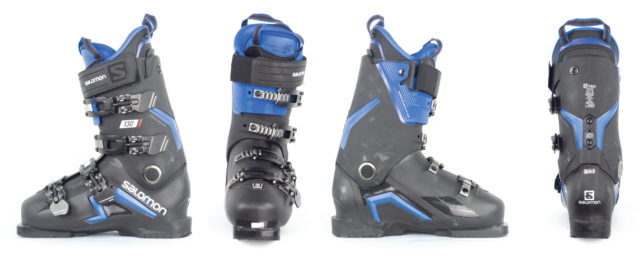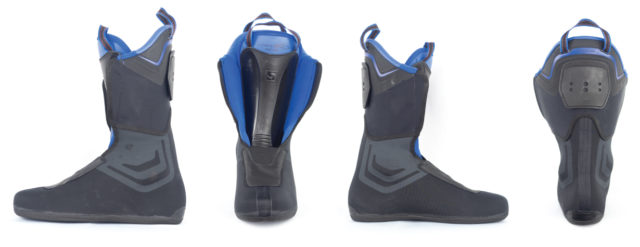Boot: 2021-2022 Salomon S/Pro 130
Stated Flex: 130
Available Sizes: 24.0-28.5
Stated Last (size 26.5): 100-106 mm (heat moldable)
Stated Forward Lean: 12.5°
Size Tested: 26.5
Stated Boot Sole Length: 305 mm
Blister’s Measured Weight (size 26.5):
- Shells, no Liners: 1367 & 1368 g
- Liners, no Footbeds: 361 & 360 g
- Shells + Liners = 1728 & 1728 g
- Removable Spoilers: 17 & 17 g
Buckles: 4 micro-adjustable aluminum
Powerstrap: 45 mm velcro
Shell Material:
- Cuff: PU (heat moldable)
- Shoe / Clog: PU + Fiberglass “Coreframe” (heat moldable)
Soles: Alpine
Binding Compatibility: standard alpine bindings; WTR bindings; Grip Walk bindings; MNC bindings
MSRP: $900
[Note: Our review was conducted on the 19/20 S/Pro 130, which was not changed for 20/21 or 21/22, apart from graphics.]

Intro
The Salomon X Pro series of ski boots is reportedly the best-selling line of ski boots in the world.
But for 19/20, Salomon is discontinuing the popular X Pro line and replacing it with an entirely new line — the S/Pro. With a lightweight, heat-moldable construction and some new tech taken from the Salomon S/Max line, the new S/Pro boots are very interesting. So let’s take a closer look at the design, features, and fit of the new S/Pro 130.
The 2019-2020 Salomon S/Pro Line of Boots
The entire S/Pro line will consist of 12 boots — 7 “men’s” models and 5 “women’s” models.
The men’s S/Pro 130, 120, 110, 100, and 90 are all available with heat-moldable shells, and then there are non-heat-moldable 90- and 80-flex options. The women’s S/Pro 100, 90, and 80 are available with heat-moldable shells, and then there are non-heat-moldable 80- and 70-flex options.
All of the S/Pro boots feature Salomon’s heat-moldable, “seamless” liners, and all boots except for the S/Pro 80 and S/Pro 70 W feature the brand’s “Coreframe” construction that we’ll talk about below.
Here’s a quick summary of the entire line:
- S/Pro 130 (PU cuff & shoe; heat moldable)
- S/Pro 120 (PU cuff & shoe; heat moldable)
- S/Pro 110 (PU cuff & shoe; heat moldable)
- S/Pro 100 (PU cuff & shoe; heat moldable)
- S/Pro 90X (PU cuff & shoe; heat moldable)
- S/Pro 90 (PU cuff & shoe)
- S/Pro 80 (PU cuff & Polyolefin shoe)
- S/Pro 100 W (PU cuff & shoe; heat moldable)
- S/Pro 90 W (PU cuff & shoe; heat moldable)
- S/Pro 80X W (PU cuff & shoe; heat moldable)
- S/Pro 80 W (PU cuff & shoe)
- S/Pro 70 W (PU cuff & Polyolefin shoe)
Weight + Comparisons
The S/Pro line reportedly uses a similar construction to their S/Max boots, which are quite light. The S/Max and S/Pro lines are part of a trend we’ve been seeing over the past few seasons — dedicated alpine / inbounds ski boots getting lighter.
At around 1730 grams per boot for a 26.5, the S/Pro 130 is quite light for a 130-flex alpine boot, though it’s not as extremely light as the K2 Recon 130 or Head Nexo LYT 130.
For reference, here are our measured weights for some other notable boots in this class, as well as some more traditional alpine boots to give an idea of the weight differences. Our measured weights show the mondo size of the boot, then the weight of each shell. Then the weight of each liner. Then the total weight for shells + liners, listed in grams:
Head Nexo LYT 130 (26.5): 1082 & 1089 + 427 & 436 = 1509 & 1525 g
K2 Recon 130 LV (26.5): 1276 & 1277 + 369 & 374 = 1645 & 1651 g
Atomic Hawx Ultra 130 (26.5): 1270 & 1267 + 425 & 426 = 1695 & 1693 g
Salomon S/Pro 130 (26.5): 1367 & 1368 + 361 & 360 = 1728 & 1728 g
Salomon S/Max 130 Carbon (26.5): 1291 & 1292 + 445 & 446 = 1736 & 1738 g
Salomon S/Max 130 (26.5): 1389 & 1407 + 433 & 429 = 1822 & 1836 g
Nordica Promachine 130 (26.5): 1428 & 1428 + 444 & 445 = 1890 & 1891 g
Head Raptor 140 RS (26.5): 1892 & 1899 + 547 & 548 = 2439 & 2447 g
Shell Construction
The S/Pro 130 features a heat-moldable PU cuff and shoe, and the shoe has Salomon’s “Coreframe” fiberglass reinforcements around the midfoot. This tech (the blue plastic around the midfoot in the picture below) is designed to increase rigidity without adding much weight, and is a part of why Salomon can make the S/Pro boots so light.

Like the S/Max boots, the S/Pro 130 features Salomon’s “Sense Amplifier Cuff,” which consists of a softer material near the top of the cuff (light blue portion of the cuff) that’s designed to allow for quicker rebound and better snow feel.
Liner
The S/Pro 130 has a very sleek, minimal liner. It’s very similar to the S/Max 130’s liner in that the S/Pro 130’s liner features a nearly seamless construction.

Overall, I’d call the S/Pro 130’s liner fairly plush, as opposed to some liners like those in the Tecnica Zero G Tour Pro and Atomic Hawx Ultra XTD 130, which have very dense liners that don’t “give” very much. One random thing I like about the S/Pro 130’s liner is that the interior material is very slippery and, combined with the flexible shell material, makes getting in and out of the boot extremely easy.
Forward Lean
The S/Pro 130 has a stated 12.5° of forward lean, and it’s not adjustable. 12.5° puts the S/Pro 130 around the middle of the spectrum — not super far forward, nor super neutral.
Buckles
Nothing too crazy here — the S/Pro 130 uses four micro-adjustable aluminum buckles that are easy to actuate while wearing gloves or mittens.
Power Strap
The S/Pro 130 features a 45mm-wide velcro-style power strap. It feels pretty substantial and seems on par with most other velcro-style power straps we see on other 130-flex alpine boots.
Fit
First and foremost — please go to a bootfitter to see what boot will work best for you. Fit is the most important thing with ski boots, and is where you’ll want to start. With that said, here’s how the S/Pro 130 fits my feet.
For reference, I have pretty average-volume feet, but I have large lateral splats which mean my midfoot widens when I am standing / skiing, and I often get pain on the outside of my forefoot and midfoot when running, skiing, skinning, etc. I have a low instep and an average to low arch. My feet tend to work best with boots that offer ample room in the midfoot, and have lower insteps (e.g., the Salomon QST Pro 130). Since my toes taper significantly (i.e., my pinkie toe is much shorter than my big toe), I’ve never needed a 6th toe punch in any boots.
Salomon says the last on the S/Pro line can be expanded in the midfoot from 100 mm all the way up to 106 mm. This puts the S/Pro 130 in the mid- to high-volume category, which is the general category that I look to in order to accommodate my wider midfoot.
Overall, the S/Pro 130 feels like a pretty average ~100mm-last boot. I haven’t heat molded it, and I have a pretty comfortable fit throughout most of the boot. The toe box feels a touch shorter than some other 26.5 boots, though it’s not nearly as short as the 26.5 Scott Cosmos III. Apart from the length, the toe box of the S/Pro 130 feels pretty roomy, and it’s similar to the Nordica Strider 120 and Dalbello Lupo 130 HD (review coming soon) in this regard.
The midfoot area of the S/Pro 130 feels pretty similar to the Nordica Strider 120 and maybe a bit narrower than the Salomon QST Pro 130. I’m pretty comfortable standing and walking in the S/Pro 130 with the buckles open, but after a few hours of skiing I’ve gotten some pretty substantial pain around my midfoot, which tends to be the case with most boots. I’m curious to see if heat-molding the boot could alleviate this.
The instep of the S/Pro 130 feels pretty average. With my low instep, I’ve got a bit of room above my foot, but not as much as the Dalbello Lupo 130 HD.
The heel of the S/Pro 130 feels roomy. I have fairly low-volume ankles and think I could benefit from adding some padding around the ankle / heel of the S/Pro 130 as I’ve gotten some heel lift while skiing and hiking.
Compared to the Salomon S/Max boots, the S/Pro 130 is much higher-volume overall. I doubt people who love the fit of either of these boots will fit well in the other — they’re pretty much opposites when it comes to fit.
Bottom Line (For Now)
The new Salomon S/Pro line takes their new lightweight construction and applies it to a roomier, more comfort-oriented fit. Blister Members can check out our initial on-snow impressions in our Flash Review linked below, and then stay tuned for our full review.
Flash Review
Blister Members can now check out our Flash Review of the S/Pro 130 for our initial impressions. Become a Blister member now to check out this and all of our Flash Reviews, plus get exclusive deals and discounts on skis, and personalized gear recommendations from us.



Am I reading this right….the larger S Pro 130 is lighter than the more race orientated and more expensive S Max Carbon?
Yep, the S/Pro is a tiny bit lighter than the S/Max 130 Carbon, though it’s a very small difference. The huge difference between the two is the fit — the S/Max boots have extremely low-volume fits, while the S/Pro’s fit is much higher-volume overall.
What about the Cuff adjustment? Is it done by heating the shell and then aligning it?
Will the Blister Crew be doing a review on the new Salomon Shift Pro Boot.
We were hoping to review it this season, but the COVID-19 situation has pushed that review to next season. But we’re planning on reviewing it next season.
I’d like to know too
Any chance you can compare the Salomon S/Pro vs. Atomic Hawk Prime and the Salomon S/Max vs. Atomic Hawk Ultra with respect to general fit?
My perception is that the S/Pro 130/120 in a 27.5 feels very roomy in the midfoot and length compared to similar boots in its class (Lange RX, Tecnica Mach1 and Atomic Hawk Prime)?
Hi folks – is there any difference on the 2023? Was actually looking at the s/pro 120 And was curious on if they made any updates to the standard volume models.
Same question as John M: did anything change on the S/Pro going into 2023?
Another question, how does the s/pro compare stiffness wise to the x/pro it replaced? I have the x/pro 120, and often wished I’d bought the 130. Now I’m going to buy the S/pro, and looking for guidance.